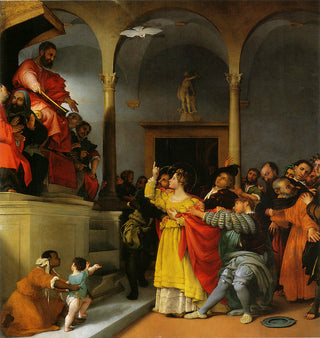On December 13th, the Roman Catholic, Anglican, Lutheran, and Orthodox Churches celebrate the feast day of St. Lucy. Yet, what is Saint Lucy known for? And why is she venerated as the patroness of the blind? Here is the true story of Saint Lucy and other amazing facts we might be interested in.

St. Lucy was a martyr of the Diocletian persecution against Christians, one of the most severe during the Roman Empire. She was born in Syracuse, Sicily, in 283 AD, and was the daughter of a rich nobleman, who died when she was still a child. Lucy grew up with her sickly mother Eutychia, a woman of Greek descent who wasn’t Christian. Nonetheless, she grew up a devout Christian. In her teenage years, she decided to consecrate her virginity to God and to devote her life to the service of the poor. However, ignoring Lucy’s promises, and worried about her daughter’s future, Eutychia arranged her marriage to a young, rich, and pagan man.
Young Lucy, who was renowned for her beauty and her sparkling eyes, refused to marry the man and followed her own spiritual calling. In the end, she persuaded her mother to respect her firm resolution and to let her devote to suffering and needy people. As Lucy’s reputation quickly increased in Syracuse, the emperor Diocletian began the last and worse persecution against Christian of all times. In those sorrowful days, fearless Lucy helped Christians hiding in the dark underground catacombs. She carried food and drink, but also comfort and relief to the persecuted.
Unfortunately, the pagan man to whom Lucy was betrothed heard of her activities, and denounced her to the Roman governor as a Christian. The governor seized this opportunity to demonstrate Rome’s greatness and power. The helpless, but very courageous young girl was arrested, tortured, and humiliated. Though, she valorously resisted to every cruel attempt to annihilate her inner strength. St. Lucy never renounced her faith, nor denied Jesus.
St. Lucy was executed in Syracuse in 304 AD, on December 13th. Her remains rest in the Basilica of St. Lucy in Syracuse, where the beautiful Caravaggio’s painting “Burial of St. Lucy” is housed too. She is one of eight women along with the Blessed Virgin Mary who is commemorated by name in the Canon of the Mass.

Food for thought
Candles, and light sources in general, along with the eyes, are the main symbols of St. Lucy’s worship*. In fact, her name (Lucy, Lucia) comes from “lux”, the Latin word for “light”. Therefore, she is worldwide venerated as the patron saint of the blind, and as an example of moral courage, integrity and purity of heart.
St Lucia: the Swedish Tradition
On December 13th, Sweden celebrates the Luciadagen, the Feast of St Lucy, during which Swedish people are used to light on their candles to fight the long obscurity of the short winter days.
This tradition has its origins in the XVIII century, thanks to some aristocratic families. The oldest daughter of each family had to bring breakfast to the bed of her own parents.
In 1927, a famous newspaper of Stockholm launched a competition: its readers had to choose the most beautiful “Lucia” in town. Since then, every year in every city of Sweden, on 13 December the most beautiful Lucias is crowned. The candidates (girls and boys) challenge each other in singing performances in private or public places, such as squares, theatres or hospitals.

This recurrence is accompanied by the procession of Sankta Lucia. The winner, together with damsels and page boys, has to march with a crown of candles upon her/his head, singing Christmas carols bringing light and offering saffron-flavored sweets.
If you would like to honor St. Lucy, you can take a look at Savelli's religious medal dedicated to the Saint Patroness of the Blind.
Related articles:
The Most Influential Catholic Women of All Times→
St Rita of Cascia: Patroness of the Impossible Causes→
St Cecilia: Patron Saint of Music→












